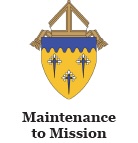Fr. John Gerritts
Pastor, St. Patrick, Hudson
Editor’s note: This is fourth in a four-part series of articles explaining the Diocese of Superior’s Maintenance to Mission Pastoral Plan.
As mentioned previously, our diocese recently released a document titled: “MAINTENANCE TO MISSION PASTORAL PLAN: Recalibrating our Structure to Move on Mission.” Writing about the plan, I mentioned that the Diocese of Superior had released pastoral plans in the past. These focused primarily on the shortage of priests our diocese was facing and how to organize the more than 100 parishes in such a way that they could be served by a dwindling number of priests. The committee tasked with developing this latest plan realized our diocese was not only facing a declining number of priests, but also a decreasing number of people in our pews and parishioners receiving the sacraments. Thus, this plan focuses more on this issue and our need to move from simply maintaining parishes to guiding all of us to regain the zeal of the early missionaries who first brought the Catholic faith to northern Wisconsin.
The last article focused on the introductory letter to the pastoral plan that Bishop James P. Powers wrote, the introduction and the first four pillars. The body of the pastoral plan is divided into six pillars. This week we will look at the fifth and sixth pillars, along with the conclusion.
Pillar 5: The Inevitability of Change and Pillar 6: Opportunities for Change
The fifth pillar speaks about “the inevitability of change.” We often hear the Catholic Church seldom changes or changes at a very slow pace. Even in the church, change will happen. Many of us have changed parishes in our lifetimes; we may have seen different priests come and others go. In many places within our diocese, some parishes have closed and others have been clustered together. Most parishes have had to change their Mass times at one time or another. Recently a new pope was elected, and he will be different from all previous popes. The important thing to remember is that change can be feared or it can be embraced. Often when it is embraced, it makes us better.
Personally, I experienced this in Rhinelander. When I was first named as a pastor there, two churches existed in that community. While I was there, the two communities, who were only a little more than a mile apart, decided to merge. While parts of this decision were difficult, it created a much stronger Catholic community there.
I have seen how youth ministry has changed in the 33 years I have been a priest. Our diocese dropped a very successful program called Teens Encounter Christ, or TEC, but it has been replaced with things like Extreme Faith Camp, Totus Tuus and Discipleship weekends. It was hard to see a successful program be dropped, but it is amazing to see the success these new opportunities are having.
Pillar Six continues this theme of change. This pillar introduces a new diocesan office called the Office of Parish Transformation. This office will assist parishes as they walk the journey of becoming more mission focused.
In addition, this pillar points out that some parishes will come to the realization that they are no longer stable or vibrant. When this occurs, the diocese has three options for them to consider.
The pastor, following consultation with parish leadership, can ask the bishop that they be suppressed and the church building(s) closed. In this situation, neighboring parishes will be guided to help welcome the parishioners of the now-closed parish into a new parish. Canon law provides guidance and direction regarding how the assets, including religious items, are protected.
Second, the pastor – again with guidance from local leadership – can ask the bishop that the parish be merged with another parish. As I wrote, we saw this happen in Rhinelander and also in Woodruff-Minocqua-Lake Tomahawk.
Finally, the pastor can request for the bishop to consider designating a parish to become an oratory. This would allow a church to be used for things such as weddings and funerals, and for Mass to be celebrated on certain feast days that are relevant to the local community.
These options all allow for the possibility of parishioners of parishes that are no longer active or stable to become a part of a community that will nourish their faith. The Conclusion to the Pastoral Plan emphasizes that in the end, the hope is that whatever changes may come our way in parishes and the diocese, we will regain some of the missionary zeal present in the apostles and those who first courageously brought the Catholic faith to northern Wisconsin. Every pope since Pope St. Paul VI has called us to be more engaged in the work of evangelization. The hope is the new Diocesan Plan will help us lay the groundwork so we can be more missionary focused across our great diocese.

